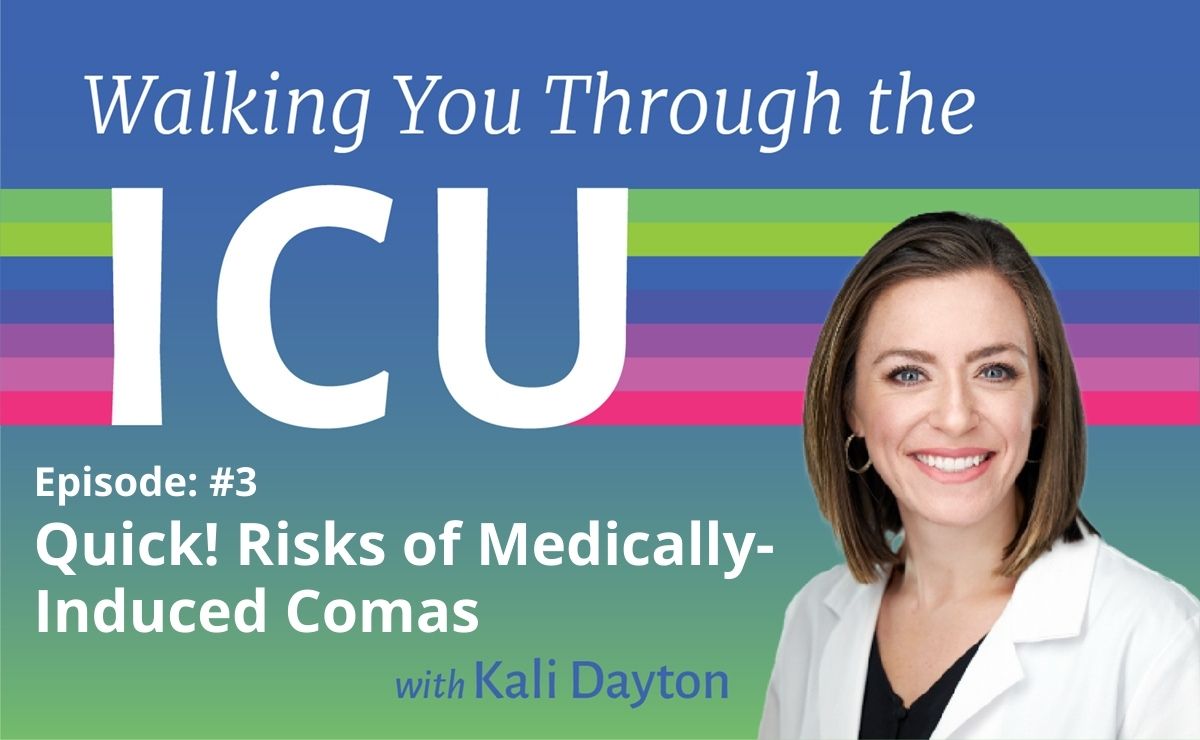SUBSCRIBE TO THE PODCAST
In this episode, Kali dives deeper into the reality, history, and culture of medically-induced comas including the risks of prolonged sedation.
Episode Transcription
Episode 2: Quick! What you need to know about medically induced-comas.
The next few episodes, we will dive deeper into the reality, history, and culture of medically-induced comas. Yet, if you or your loved one is facing the possibility of being on a ventilator in the ICU, there are some vital things you need to know NOW- so I’m going to tell it to you straight. I’ll explain more in the next few episodes- but here is your quick crash course.
Ready?
- Medically-Induced comas are not necessary for every patient on a ventilator
- Medically-induced comas are only essential in some extreme cases such as active seizures, difficulty keeping oxygenated with movement, too much pressure in the brain, open abdomen, and so forth.
- The following are risks involved in medically-induced comas and why we should avidly avoid deep sedation for patients on ventilators when it is NOT necessary and why we should be carefully evaluating the type and dose of sedation given to patients that do require sedation on a ventilator.
You need to know that prolonged sedation increases the risks of:
- Death- in the ICU or after the ICU [1, 2]
- Hospital-acquired infection [3,4]
- Pressure injuries (or bed sores) [5]
- Blood clots [6]
- Delirium [7,8,9]
- ICU acquired weakness[10]
- More time on the ventilator [11]
- More time in the hospital [12]
- Tracheostomy [13]
- Discharge from hospital to long-term acute care hospital, rehabilitation center, or nursing home[14]
- Post-ICU PTSD[15, 16]
- Post-ICU dementia (cognitive dysfunction) [17]
- Depression[18]
- Being readmitted to the hospital and ICU [19]
- Post-Intensive Care Syndrome [20]
Sedation decreases the chances of:
- Discharging home from the hospital [14]
- Being able to walk upon transfer from the ICU [21]
- Returning to work [22]
- Optimal quality of life [23]
Avoiding sedation and early mobility (ABCDEF Bundle) decrease the risks of:
- Death [24]
- Ventilator and hospital associated pneumonia [25]
- Central Line and catheter infections [26]
- Pressure injuries [27]
- Falls [28,29]
- Delirium [24]
- Aspiration Pneumonia [30]
- Constipation/ileus [31]
- Intubation [14]
- Re-intubation [14]
- Tracheostomy and PEG tube placements [32]
- Discharges to care facilities [24]
- Hospital and ICU readmissions [24]
- Diaphragm dyfunction [33]
- ICU Acquired Weakness [34]
Improves:
- Successful getting the breathing tube taken out and off the ventilator [24]
- Discharges from ICU [24]
- Discharging directly home [24, 35]
- Survival [24]
- Functional independent after discharge [36]
- Quality of life [37]
- Lung aeration [38]
- Secretion clearance [39]
I’m not sure why this isn’t a standard part of the informed consent prior to intubation… but regardless of what our system is programmed to teach you, you have the right to know and choose- in most cases.
Even if your loved one has been sedated for too long before you learned this… or if deep sedation is essential for your loved one right now, it is important to be aware of the effects of these medications so you can help get them off of them as soon as possible and be prepared to help your loved one rehabilitate and combat the damage they may cause.
The citations to the support studies for all of this can be found on the blog. This is further explained in the free ebook on my website. We will dive deeper into this in the next episodes, so keep listening. I just needed you to hear this right now before you or your loved one is intubated. Time is precious right now.
Resources Referenced:
- Shehabi, et al. (2012). Early intensive care sedation predicts long-term mortality in ventilated critically ill patients. American journal of respiratory and critical care medicine, 186(8), 724–731. https://doi.org/10.1164/rccm.201203-0522OC
- Tanaka, et al. (2014). Early sedation and clinical outcomes of mechanically ventilated patients: a prospective multicenter cohort study. Critical care (London, England), 18(4), R156. https://doi.org/10.1186/cc13995
- Lin, et al. (2008). Risk factors for the development of early-onset delirium and the subsequent clinical outcome in mechanically ventilated patients. Journal of critical care, 23(3), 372–379. https://doi.org/10.1016/j.jcrc.2006.09.001
- Rello, J., Diaz, E., Roque, M., & Vallés, J. (1999). Risk factors for developing pneumonia within 48 hours of intubation. American journal of respiratory and critical care medicine, 159(6), 1742–1746. https://doi.org/10.1164/ajrccm.159.6.9808030
- Cox, J., Roche, S., & Murphy, V. (2018). Pressure Injury Risk Factors in Critical Care Patients: A Descriptive Analysis. Advances in skin & wound care, 31(7), 328–334. https://doi.org/10.1097/01.ASW.0000534699.50162.4e
- Minet, C., Potton, L., Bonadona, A., Hamidfar-Roy, R., Somohano, C. A., Lugosi, M., Cartier, J. C., Ferretti, G., Schwebel, C., & Timsit, J. F. (2015). Venous thromboembolism in the ICU: main characteristics, diagnosis and thromboprophylaxis. Critical care (London, England), 19(1), 287. https://doi.org/10.1186/s13054-015-1003-9
- Pandharipandh, P., Shintani, A., Peterson, J., Truman, B., Wilkinson, G., Dittus, R., Bernard, G., Ely, W.(2006). Lorazepam is an independent risk factor for transitioning to delirium in intensive care unit patients, Anesthesiology, 104. Retrieved from https://pubs.asahq.org/anesthesiology/article/104/1/21/7483/Lorazepam-Is-an-Independent-Risk-Factor-for
- Yang, J., Zhou, Y., Kang, Y., Xu, B., Wang, P., Lv, Y., & Wang, Z. (2017). Risk Factors of Delirium in Sequential Sedation Patients in Intensive Care Units. BioMed research international, 2017, 3539872. https://doi.org/10.1155/2017/3539872
- Pereira, J. V., Sanjanwala, R. M., Mohammed, M. K., Le, M. L., & Arora, R. C. (2020). Dexmedetomidine versus propofol sedation in reducing delirium among older adults in the ICU: A systematic review and meta-analysis. European journal of anaesthesiology, 37(2), 121–131. https://doi.org/10.1097/EJA.0000000000001131
- Vanhorebeek, I., Latronico, N., & Van den Berghe, G. (2020). ICU-acquired weakness. Intensive care medicine, 46(4), 637–653. https://doi.org/10.1007/s00134-020-05944-4
- Shehabi, et al. (2012). Early intensive care sedation predicts long-term mortality in ventilated critically ill patients. American journal of respiratory and critical care medicine, 186(8), 724–731. https://doi.org/10.1164/rccm.201203-0522OC
- Strøm, T., Martinussen, T., & Toft, P. (2010). A protocol of no sedation for critically ill patients receiving mechanical ventilation: a randomised trial. Lancet (London, England), 375(9713), 475–480. https://doi.org/10.1016/S0140-6736(09)62072-9
- Brook, A. D., Ahrens, T. S., Schaiff, R., Prentice, D., Sherman, G., Shannon, W., & Kollef, M. H. (1999). Effect of a nursing-implemented sedation protocol on the duration of mechanical ventilation. Critical care medicine, 27(12), 2609–2615. https://doi.org/10.1097/00003246-199912000-00001
- Pun, et al. (2019). Caring for Critically Ill Patients with the ABCDEF Bundle: Results of the ICU Liberation Collaborative in Over 15,000 Adults. Critical care medicine, 47(1), 3–14. https://doi.org/10.1097/CCM.0000000000003482
- Davydow, D. S., Gifford, J. M., Desai, S. V., Needham, D. M., & Bienvenu, O. J. (2008). Posttraumatic stress disorder in general intensive care unit survivors: a systematic review. General hospital psychiatry, 30(5), 421–434. https://doi.org/10.1016/j.genhosppsych.2008.05.006
- Nelson, B. J., Weinert, C. R., Bury, C. L., Marinelli, W. A., & Gross, C. R. (2000). Intensive care unit drug use and subsequent quality of life in acute lung injury patients. Critical care medicine, 28(11), 3626–3630. https://doi.org/10.1097/00003246-200011000-00013
- Wilcox, M. E., Brummel, N. E., Archer, K., Ely, E. W., Jackson, J. C., & Hopkins, R. O. (2013). Cognitive dysfunction in ICU patients: risk factors, predictors, and rehabilitation interventions. Critical care medicine, 41(9 Suppl 1), S81–S98. https://doi.org/10.1097/CCM.0b013e3182a16946
- Desai SV, Law TJ, Needham DM. Long-term complications of critical care. Crit Care Med. 2011 Feb;39(2):371-9. doi: 10.1097/CCM.0b013e3181fd66e5. PMID: 20959786.
- Tanaka, et al. (2014). Early sedation and clinical outcomes of mechanically ventilated patients: a prospective multicenter cohort study. Critical care (London, England), 18(4), R156. https://doi.org/10.1186/cc13995
- Rawal, G., Yadav, S., & Kumar, R. (2017). Post-intensive Care Syndrome: an Overview. Journal of translational internal medicine, 5(2), 90–92. https://doi.org/10.1515/jtim-2016-0016
- Vanhorebeek, I., Latronico, N., & Van den Berghe, G. (2020). ICU-acquired weakness. Intensive care medicine, 46(4), 637–653. https://doi.org/10.1007/s00134-020-05944-4
- Cox, J., Roche, S., & Murphy, V. (2018). Pressure Injury Risk Factors in Critical Care Patients: A Descriptive Analysis. Advances in skin & wound care, 31(7), 328–334. https://doi.org/10.1097/01.ASW.0000534699.50162.4e
- Nelson, B. J., Weinert, C. R., Bury, C. L., Marinelli, W. A., & Gross, C. R. (2000). Intensive care unit drug use and subsequent quality of life in acute lung injury patients. Critical care medicine, 28(11), 3626–3630. https://doi.org/10.1097/00003246-200011000-00013
- Mart, M., Brummel, N., & Ely, W. (2019). The abcdef bundle for the respiratory therapist. Respiratory Care, 64(12). http://rc.rcjournal.com/content/64/12/1561
- Clark, et al. (2013). Effectiveness of an early mobilization protocol in a trauma and burns intensive care unit: a retrospective cohort study. Physical Therapy, 92(2). https://pubmed.ncbi.nlm.nih.gov/22879442/
- Hunter, A., Johnson, L., & Coustasse, A. (2014). Reduction of intensive care unit length of stay: the case of early mobilization. Health Care Management, 33(2). https://pubmed.ncbi.nlm.nih.gov/24776831/
- Azuh, et al. (2016). Benefits of early active mobility in the medical intensive care unit: a pilot study. American Journal of Medicine, 129(8). https://pubmed.ncbi.nlm.nih.gov/27107920/
- Hshieh, et al. (2015). Effectiveness of multicomponent nonpharmacological delirium interventions: a meta-analysis. Journal of American Medical Association Internal Medicine, 175(4). https://pubmed.ncbi.nlm.nih.gov/25643002/
- Inouye, S., Finke, B., & Burrows, I. (2017). Mobility action group. Center For Medicare and Medicaid services. https://www.hhs.gov/guidance/sites/default/files/hhs-guidance-documents/mobility%20action%20group%20change%20package%20and%20toolkit_3.pdf
- d’Escrivan, & Guery, B. (2005). Prevention and treatment of aspiration pneumonia in intensive care unit. Treatments in Respiratory Medicine, 4. https://link.springer.com/article/10.2165/00151829-200504050-00003
- Sutton, et al. (2021). Impact of the 2018 society of critical care medicine pain, agitation/sedation, delirium, immobility, and sleep guidelines on nonopioid analgesic use and related outcomes in critically ill adults after major surgery, Critical Care Explorations, 3(10).
- Brook, et al. (1999). Effect of a nursing-implemented sedation protocol on the duration of mechanical ventilation. Critical Care Medicine, 27(12).
- Dong, et al. (2021) Early rehabilitation relieves diaphragm dysfunction induced by prolonged mechanical ventilation: a randomized control study. BMC Pulmonary Medicine, 21(106).
- Lipshutz, A., & Gropper, M. (2013). Acquired neuromuscular weakness and early mobilization in the intensive care unit. Anesthesiology, 118(1).
- Ota, et al. (2015). Effect of early mobilization on discharge disposition of mechanically ventilated patients. Journal of Physical Therapy Sciences, 27(3). https://www.ncbi.nlm.nih.gov/pmc/articles/PMC4395731/
- Schujmann, et al. (2019). Impact of a progressive mobility program on the functional status, respiratory and muscular systems of icu patients: a randomized and controlled trial. Critical Care Medicine.
- Ely, W. (2017). The abcdef bundle: science and philosophy of how icu liberation serves patients and families. Critical Care Medicine, 45(2). https://www.ncbi.nlm.nih.gov/pmc/articles/PMC5830123/
- Elmer, et al. (2021). The effect of physical therapy on regional lung function in critically ill patients. Front Physiology, 12. https://www.ncbi.nlm.nih.gov/pmc/articles/PMC8488288/
- Strickland, et al. (2013). Aarc clinical practice guideline effectiveness of nonpharmacologic airway clearance therapies in hospitalized patients. Respiratory Care, 58(12). https://pubmed.ncbi.nlm.nih.gov/24222709/
SUBSCRIBE TO THE PODCAST



 When patients are so ill that they require a ventilator in the ICU, the antiquated approach of heavy sedation and immobilization should be avoided in order to help prevent the immense burden of physical and cognitive disabilities suffered during survival. To understand this better, listen to Walking Home From The ICU. You will see what ICU consultant Kali Dayton provides to your team.
When patients are so ill that they require a ventilator in the ICU, the antiquated approach of heavy sedation and immobilization should be avoided in order to help prevent the immense burden of physical and cognitive disabilities suffered during survival. To understand this better, listen to Walking Home From The ICU. You will see what ICU consultant Kali Dayton provides to your team.
